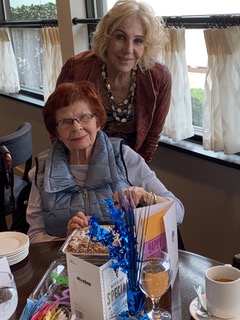Caring for Mom wins out over love of Bay Area for longtime resident still working but long distance
Diane Reynolds relocated to the Bay Area when she was 26. San Francisco is “so accepting of things, I knew this was the home I was looking for.” Four years ago, she returned to Maryland, where she was born, to be available when her mother needed her. It was not an easy decision. Leaving meant walking away from everything she had come to enjoy over the last 40 years.
“To leave at 68 years old, when most of my friends and acquaintances were in the Bay Area, even though I was leaving for a reason, how would I adjust? The unknown scared me. Would I meet people? Would I find my niche?”
She mulled over the decision for several years, but when she finally committed, “there was no looking back.” She knew she wouldn’t be able to help from across the country.
Commuting was not an option
She had already been through 14 years of flying back and forth to Maryland every three months, of having “one foot in both places,” to care for a father with a slow-growing brain tumor.

Though she lived on the other side of the country, while her siblings lived much closer to their parents, as the oldest of three children and the only one without children, Reynolds provided the primary support for her mother, a suburban housewife turned travel agent, during her father’s illness. And now, she has now assumed the primary caregiving role for her mother.
But today, she says, “I feel so lucky to be here with my mom. I know I made the right decision, though I didn’t know it then.” Her mother, 95-year-old Evelyn Perlmutter, agrees. “I was apprehensive. After college, Diane never really returned home. We were used to being independent.”
The two agreed that Reynolds would temporarily move into her mother’s three-bedroom condominium while she looked for her own place. But when they realized that living together worked for them, the temporary became permanent. It works because “we still live fairly independent lives. “She works while I read,” her mother said.
Unpaid Caregiving on the Increase
Unpaid caregiving is increasing in prevalence as the U.S. population continues to age and live longer with more complex and chronic conditions, according to”Caregiving in the U.S. 2020,” a research study published in May by The National Alliance for Caregiving and the AARP. Unpaid caregivers are serving as a core piece of the health and long-term support service systems, as well as the main source for long-term care for adults living at home and in the community. An estimated 41.8 million U.S. adults provide informal (unpaid) care to another adult, a significant increase from the estimated 34.2 million Americans doing so in 2015. Most (89 percent) care for a parent or parent-in-law (50 percent), spouse or partner (12 percent), grandparent or grandparent-in-law (8 percent) or adult child (6 percent). Ten percent provide care to a friend or neighbor. Most of that care, 66 percent, continues to be provided by women.
Starting new businesses
After graduating from a dental tech program in Philadelphia, Reynolds moved to Basel, Switzerland, where she worked as a dental hygienist. Two years later, after a brief stay in Maryland, she moved to the Bay Area. In the mid-’70s, soon after arriving here, she launched Dental Fills-In, a temporary placement agency for dental hygienists. Her service was the first in what has since become a burgeoning field. “First in, first out,” said one of her competitors when she shuttered it in 1990, “and the only one to make a profit.”
In 1992, she and her then-husband started the SF Downtown Magazine, a monthly publication of people, events, and happenings. The work was both fulfilling and consuming. In 2006, the magazine closed for lack of funds. By then, Reynolds had started her own marketing business, received a patent for a hand washing station at gas pumps, and pioneered one-stop shopping for businesses advertising in neighborhood papers.
Work, friends, a new relationship, evenings at the SF Jazz Center and other nightspots – her life was full. Though her mother was doing well on her own, she knew a time was coming when her mother would need her and that she had better be ready.
Reynold’s parents had sold their home and bought a condominium in Leisure World of Maryland 25 years ago, which meant that Reynolds not only had to adjust to living with her mother but to life in an age-restricted, gated community. At first, she was “very apprehensive and rather shy, but as I got more acclimated, I looked forward to connecting with other people. People go out of their way to include you here.”

Neighborhood newspapers
In pre-pandemic days, she volunteered with a tour company that offered local day trips for Leisure World residents, learned to play mahjong and began to attend the “Friday night dances at the Clubhouse.” Friendships followed. It helped, too, that she maintained many of her Bay Area clients, including the San Francisco Municipal Transit Agency and OnLok Senior Care.
She still helps sell ads for the remaining publications of the San Francisco Neighborhood Newspaper Association. In 1995, when she began selling ads for SF Downtown, Reynolds realized other neighborhood papers and many of her clients would benefit from her outreach efforts. The neighborhood newspaper scene has changed a lot: from 16 papers when she started to eight papers today. But the good news, she said, “is that people still like the idea of a local paper where they can read about what is happening in their specific area.”
While joining activities and making new friends in Maryland was important, her major focus was on sharing her father’s musings during his long illness. A writer and editor, her father during his last years always carried a small notebook where he wrote down humorous observations of everyday life.
Sharing her father’s happiness

Reynolds edited those reflections into a book of insights, “Glimpses of Happiness: Laughter for the Soul.” Creating and publicizing the book, she explains, is her “way of sharing her father’s legacy.” While marketing during a pandemic is difficult, the book is slowly gaining popularity in senior communities, hospitals, and nursing homes, she said.
And then there was the event that convinced Reynolds she had made the right decision, that “the timing was right.” Two years ago, in a freak accident, her mother was run over in the parking lot of the Medical Center. Reynolds, who was just recovering from knee replacement surgery, was there to take care of her. “I didn’t want to not be here if she needed me. Turned out she definitely needed me.
“I don’t know where I’ll end up, but it’s good that I’m here. I cherish these years with her. It was the most important thing for me to do.”






